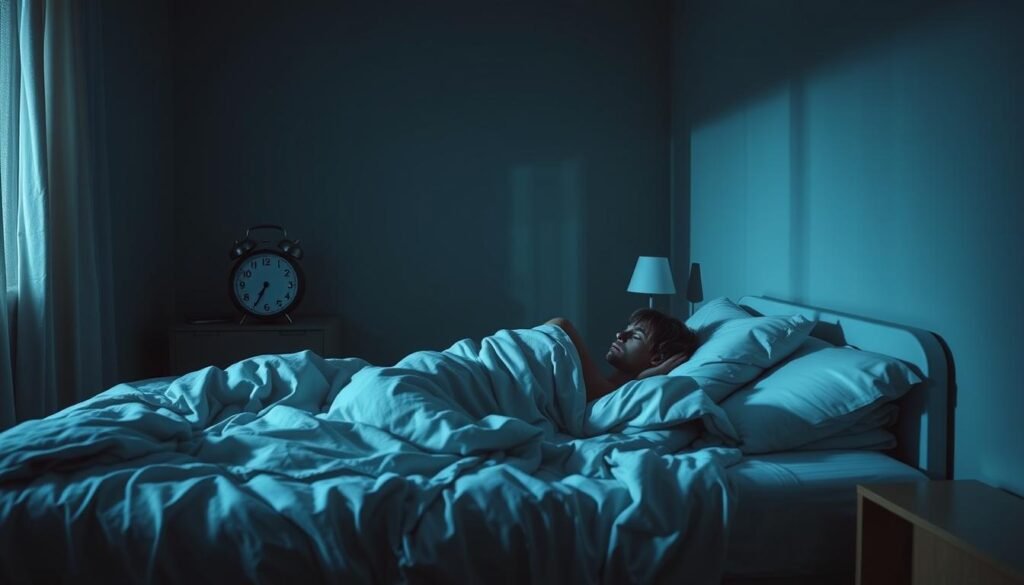Between 1 to 3 million people in the United States have Postural Orthostatic Tachycardia Syndrome (POTS). This condition is more common in women, by nearly five times. It causes an excessive increase in heart rate when standing. POTS leads to symptoms like chronic fatigue and sleep issues. It’s important to understand this postural orthostatic tachycardia syndrome for better quality of life.
People with POTS face a lot of sleep challenges. They feel very sleepy during the day and have trouble staying asleep at night. This makes their daily energy levels low. The autonomic nervous system plays a big role in sleep for POTS patients. We will explore how these body responses affect those with POTS. It has a big impact on their health and life.
Key Takeaways
- POTS affects between 1 to 3 million individuals in the U.S., with a significantly higher prevalence in women.
- The condition leads to various symptoms, prominently including fatigue and sleep disturbances.
- Approximately 50% of POTS patients attribute their quality of life challenges to sleep issues.
- Elevated daytime sleepiness is common among POTS patients, impacting their daily activities.
- Recognizing and addressing sleep disturbances can greatly improve overall health in POTS patients.
Understanding Postural Orthostatic Tachycardia Syndrome (POTS)
Postural orthostatic tachycardia syndrome, known as POTS, involves a significant heart rate increase when standing up. This condition shows signs like dizziness, feeling weak, and tiredness. These symptoms show there might be a problem with the body’s autonomic nervous system.
Research shows POTS affects between one to three million people in the U.S. It’s more common in teenagers and young adults, especially women. The symptoms often start during puberty and may be linked to conditions like Ehlers-Danlos syndrome. There’s also a connection to long-term issues after COVID-19.
About 31.6% of people with POTS have trouble sleeping. This issue can make their fatigue worse and lower their life quality. Sleep studies found that POTS patients spend more time in light sleep stages and have unstable heart rates at night. This highlights how important the autonomic nervous system is for sleep.
It’s critical to know about postural orthostatic tachycardia syndrome to manage it better. People with this condition need to be aware of it. Often, it’s not recognized or is wrongly diagnosed.
Symptoms of POTS and Their Impact on Daily Life
POTS affects about 1 to 3 million people in the U.S. It mostly hits women and folks born female aged 15 to 50. They face a bunch of tough symptoms that really change their lives. These symptoms can make them feel dizzy, faint, and super tired.
More than half of the patients deal with intense fatigue. This makes daily stuff, jobs, and relationships hard to keep up with.
People with POTS often feel very sleepy in the daytime too. This makes it hard to stay focused and do tasks. Their daily life turns into trying to manage symptoms and get through the day.
Symptoms can change over time, which can be really uncertain for those affected. Some folks might feel better with lifestyle changes like diet and exercise. It’s key for doctors to get how POTS varies and to plan care that really fits the person.
| Symptom | Impact on Daily Life |
|---|---|
| Fatigue | Limits daily activities, affects social interactions, reduces work productivity. |
| Daytime Sleepiness | Interferes with concentration, increases risk of accidents, complicates daily tasks. |
| Dizziness and Fainting | Hinders mobility, creates anxiety, may lead to isolation due to fear of symptoms. |
| Quality of Life | Overall diminished due to combination of symptoms affecting physical, emotional, and social well-being. |
Knowing the symptoms of POTS and how they impact life is crucial for healthcare workers. It helps them create care plans that really help. Early diagnosis and solid care plans support people with this chronic illness.
Role of the Autonomic Nervous System in Sleep
The autonomic nervous system plays a key role in sleep. It controls heart rate, blood pressure, and hormones. These are crucial for good sleep. When these systems don’t work right, sleep problems can happen. This affects how we sleep and stay asleep.
For people with conditions like POTS, understanding this system is vital. This condition messes with normal regulation, making good sleep hard. Nighttime symptoms like faster heart rates and changing blood pressures can disturb sleep. They mess with normal sleep cycles.
- Heart rate variability is important for reaching deep sleep stages.
- When hormonal levels are off, falling and staying asleep becomes harder. This also affects REM sleep, which helps us recover.
- Stress impacts the autonomic nervous system, leading to reactions that make sleeping difficult.
Understanding how the autonomic nervous system interacts with sleep is key. This knowledge is crucial for improving sleep in those with autonomic dysfunction. Targeted actions can make a big difference.

How Autonomic Dysfunction in POTS Affects Sleep
Autonomic dysfunction in Postural Orthostatic Tachycardia Syndrome (POTS) changes how people sleep. Those with POTS often struggle with their sleep, feeling very tired during the day. It’s important to understand how these symptoms work together to see what POTS patients go through.
Fatigue and Daytime Sleepiness
People with POTS deal with chronic fatigue. This makes them very sleepy during the day. It’s hard for them to get the deep sleep their bodies need.
Because of this, focusing and staying alert is harder for them. They run out of energy faster than healthy people do.
Insomnia and Poor Sleep Quality
Many POTS patients have insomnia, making good sleep hard to get. Falling asleep, staying asleep, and waking up feeling good are all problems. Their sleep cycles are messed up, which makes sleeping well tough.
Medicines can make sleep problems worse. But, good sleep habits can help. Using hydration solutions like NormaLyte may also improve sleep for some.

Sleep Disturbances Common in Patients with POTS
Studies highlight sleep issues in those with Postural Orthostatic Tachycardia Syndrome (POTS). They show sleep differences versus healthy individuals, underlining the sleep problem’s complexity.
Polysomnography Findings
Polysomnography gives key insights into POTS patients’ sleep patterns. It shows they have more stage 2 sleep and less rapid eye movement (REM) sleep. Specifically, they have only 18.4% REM sleep, stressing the need for objective sleep quality measures.
Subjective Sleep Qualities Compared to Healthy Controls
Self-reports indicate POTS patients have worse sleep than healthy people. They score higher on the Pittsburgh Sleep Quality Index (PSQI) and the Epworth Sleepiness Scale (ESS). Even without clear sleep pathologies in polysomnography, the poor day sleepiness and sleep issues call for detailed checks.
The heart rate changes during sleep might link to the bad sleep experience. More research is aimed at understanding this connection. Learn more about sleep quality and insomnia here.

The Link Between Orthostatic Intolerance and Sleep Issues
Orthostatic intolerance is tightly linked to sleeping problems in people with POTS. This condition makes it hard for the body to manage blood flow when someone stands up. As a result, it messes with the sleep needed to feel refreshed.
At the heart of both orthostatic intolerance and sleep problems lies autonomic dysfunction. This issue creates a tough situation for many dealing with these health concerns.
Studies show that orthostatic intolerance can increase stress responses. This, in turn, affects how well one sleeps. People may struggle to fall or stay asleep, causing tiredness and being sleepy during the day. It’s clear that these issues are deeply connected, underlining the importance of dealing with them together.
Knowing how orthostatic intolerance and sleep issues are related is key to better patient care. By tackling these challenges, we can improve sleep habits. This leads to better health for those with autonomic dysfunction.
| Aspect | Orthostatic Intolerance | Sleep Problems |
|---|---|---|
| Definition | Inability to maintain blood flow while standing | Difficulties falling or staying asleep |
| Underlying Cause | Autonomic dysfunction | Linked to autonomic dysfunction |
| Common Symptoms | Dizziness, fatigue, anxiety | Insomnia, poor sleep quality |
| Effects on Daily Life | Reduced ability to stand or perform tasks | Daytime fatigue and cognitive difficulties |
Managing Sleep Problems in POTS Patients
Dealing with sleep issues in people with Postural Orthostatic Tachycardia Syndrome (POTS) needs a detailed plan. Treatment often includes better sleep habits. This is key for good health. Tips include creating a good sleep setting, sticking to a sleep routine, and using relaxation techniques before bed.
Making a good sleeping area is really helpful. Keeping the room at a comfy 65°F (18°C) helps you sleep better. It’s important to limit caffeine to under 300 mg daily. Caffeine can mess with your sleep. Also, having a calming nighttime routine, like reading, helps your body get ready for sleep.
Using certain medicines can also help with sleep issues. Things like melatonin, 5-HTP, and magnesium can make your sleep better. Sometimes, doctors prescribe medications such as Clonidine, Trazodone, Klonopin, and Xanax. These focus on specific symptoms of autonomic dysfunction.
Working with a team of medical professionals is crucial. This should include experts in neurology, sleep medicine, and psychiatry. They help manage sleep issues well. For those really tired, starting with gentle exercises can help. This boosts better sleep and energy levels gradually.
In summary, managing sleep problems in people with POTS needs a plan that covers many areas. This plan should include changing your lifestyle, possible medication, and getting help from doctors. By working on better sleep habits and getting the right treatment, people can improve their sleep. This leads to better health overall.
Conclusion
In conclusion, autonomic dysfunction affects sleep in people with POTS in a big way. Knowing about this issue helps patients and doctors improve life quality for those impacted. Considering that between 500,000 to 3 million Americans have POTS and most are women of childbearing age, it’s key to understand sleep problems, tiredness, and how to manage them.
Research shows that 31.6% of those with POTS have trouble sleeping. This proves a strong link between autonomic dysfunction and how well they sleep. Looking at therapies based on new research might help find better treatments. Improving sleep could also lower the other tough symptoms of POTS.
Raising more awareness and working on treatment strategies is crucial. Future studies could make clear how POTS, sleep issues, and autonomic dysfunction are connected. Focusing research on treatments like low-dose naltrexone and IV immunoglobulin can help. For more insights, exploring autonomic dysfunction in detail offers additional help and advice. The effort to improve health and sleep for POTS patients is ongoing. It shows why working together in research and healthcare is so important.